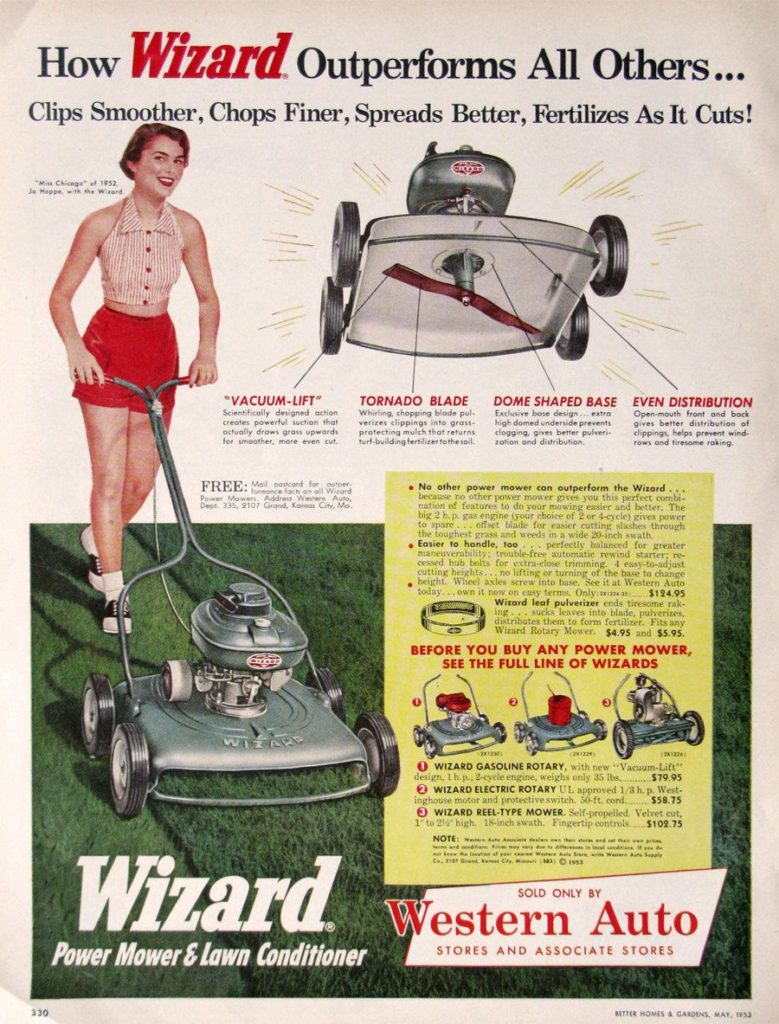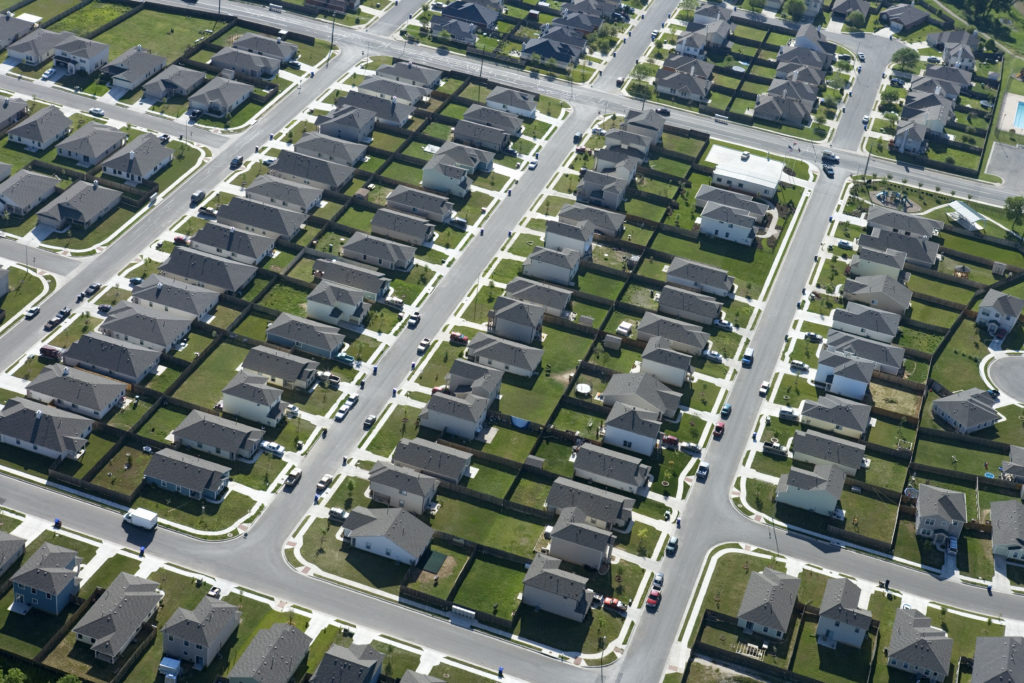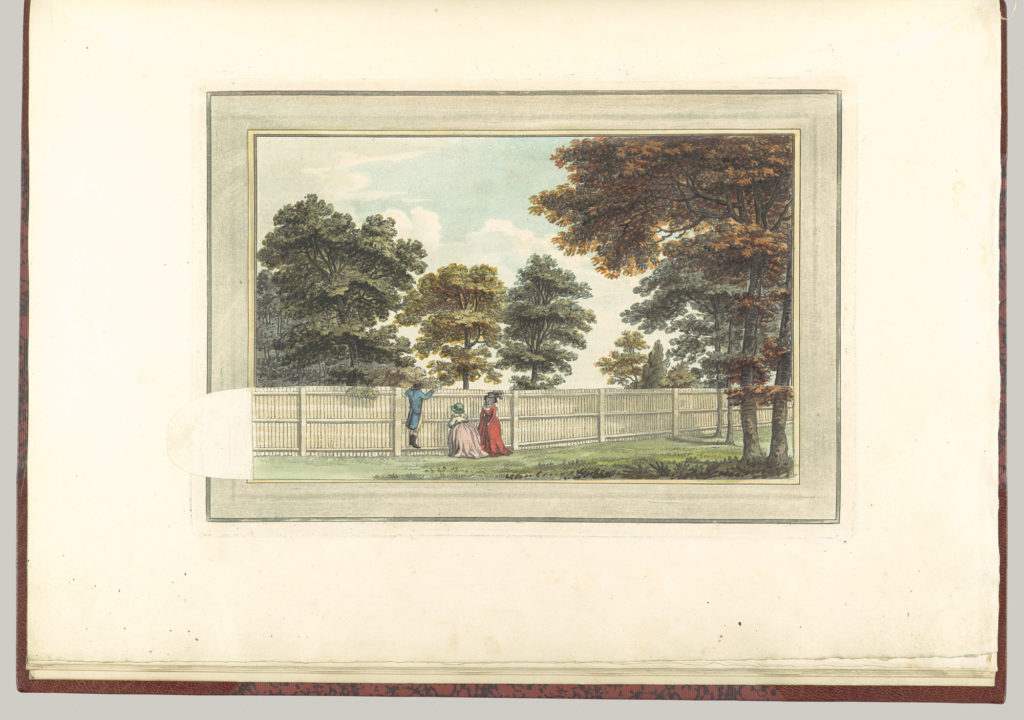June 26, 2018
By Briauna Barrera
Imagine: You’re walking through your neighborhood one warm summer evening. The sun is sinking into the horizon, and the cicadas are starting their nightly chorus. Bats are swooping in the sky. The scent of a nearby grill lingers in the air. Automated sprinklers and homeowners alike water vibrant green lawns, excess water swirling lazily onto sidewalks and down sewer drains. This is familiar, this is home.
Lawns appeared in England and France in the 1800s as a showcase wealth and nobility. The idea reached the United States through literature and art from England in the late 18th century and was similarly used by landowners to convey their status. In the 1830s and 1840s, as cities in the US become more congested and polluted due to the Industrial Revolution, wealthy families began to move outside the city in order to escape the issues of urbanization. In these new suburban landscapes, the upper class adopted the stylings of the elite in England and France. Then at the beginning of the 20th century, the United States Department of Agriculture, the United States Golf Association, and Garden Club Of America encouraged the proliferation of lawns due to its potential as a profitable industry. During this same time, the United States shifted from a producer society to consumer society and much of the individually owned land, especially in cities and suburbs, was no longer needed to produce food for domestic animals or vegetables for the family. Advertising encouraged people to have lawns and buy lawn-care products and by the 1930s, lawns were viewed as a normal and expected feature of middle-class suburban landscapes.
With the economic boom following World War II and the passage of the GI Bill, which allowed returning soldiers to afford college educations and ownership of detached single-family homes, there was a dramatic increase in suburban development. Automobile-centric policy and corporate practices, in large part through lobbying from car manufacturers, also supported the rapid increase in suburban development, as the increase in mass production of cars made them more affordable for private ownership and the drastic expansion of the U.S. highways systems under the Federal-Aid Highway Act of 1956, gave residents an avenue out of deteriorating urban areas into the surrounding suburbs. While white residents fled in droves from cities, known as White Flight, people of color were often prohibited from moving into the suburbs through racists practices such as red-lining. Thus, the sharp rise of suburbia resulted in an increasingly stark urban landscape defined by race and allowed white families to join the middle class and start building generational wealth that that was harder for families of color to obtain. The American lawn became a staple for the well-to-do middle class and continued its legacy of showcasing wealth, status, and consumption.
The Green Revolution, a period of rapid technological advances in agricultural technology and federally-supported agriculture research increased people’s ability to maintain grass lawns in any climate. Now that grass lawns were within reach for families across the nation, the United States Golf Association (USGA) and the National Gardening Association (NGA) sought to expand their power and influence through the new patch of empty land surrounding each middle class American home. The NGA did so by hosting garden workshops that educated people on the proper way to grow and maintain lawns, hosting gardening contests, and volunteering within local communities. While gardening groups and clubs shifted their focus to growing ‘victory gardens’ consisting of vegetables to support the wartime effort during World War I, after the war, focus shifted back to growing flowers instead of vegetables and beautification efforts rather than using gardens, lawns, and community spaces for practical measures. Advertisements also ramped up, with ads and articles about gardens starting to appear in magazines like Better Homes and Gardens. Beautification gardening and golf, leisurely and status-laden activities, became available to the middle class who were increasing in numbers in the suburbs and creating a lifestyle in which grass became paramount.

Wizard Power Mower & Lawn Conditioner advertisement, 1953
The commitment of American consumption and advertising resulted in the creation of a financial and laborious expenditure for home-owning Americans who were expected to spend vast amounts of time and money in the upkeep of something that produced nothing. Currently, the average homeowner spends about 70 hours a year maintaining their lawn and Americans households spent around $29.5 billion on lawn care and gardening services in 2015. However, people are not instinctively compelled to care for lawns, at least not when lawns were first introduced, but many people learned “to keep their front yards in presentable condition as dictated by community cleanup campaigns and school programs, as well by advertising. Advertising, as a result of a country driven more and more by consumption and production, manufactured a false need for lawns that came at the consumer’s and the environment’s expense.
Lawns have a distinct impact on the appearance of the American landscape through the introduction of non-native and invasive plants across the United States. Many of the common grasses used for lawns, such as Kentucky bluegrass or Bermuda grass, are not native to the North American continent and were brought over to familiarize the landscapes for colonists, to graze animals that were accustomed to European flora, and by accident, as when grass seeds were present in the hay of livestock on ships. Eventually these non-native grasses became the grasses people used for their lawns. As lawns spread across the United States, so too did invasive and non-native grass species spread. These grass species drove out other, native species of grass, decreasing biodiversity and disrupting the local food webs as a result.
Lawns are an intensive use of resources, especially water. According to the EPA, nationwide use of landscape irrigation makes up approximately one-third of all residential water use, totaling more than seven billion gallons per day, and up to 50 percent of water used for irrigation is wasted due to evaporation, wind, or runoff caused by overwatering. Lawns not only waste resources, but they are also an inefficient use of land. As lawns became more commonplace, it became increasingly taboo for lawns to serve a purpose other than aesthetics. When lawns were first introduced, they served various functions, such as grazing for livestock, but by the 20th century, functionalist lawn us had all but died out. However, lawns take up an estimated 40 million acres of land in the continental United States or almost two percent of surface in the contiguous U.S. If grass were counted as a crop, it would take up three times as much space as irrigated corn.
Lawns maintenance uses an inordinate amount of fertilizers, pesticides, herbicides, and insecticides. Lawns use about 30,000 tons of pesticides yearly in the United States. However, the effects of these toxic chemicals do not stop at the land; excess phosphorus and nitrogen runoff from lawn fertilizer enters waterways, and the increased amounts of dissolved nutrients cause algae blooms that siphon oxygen out the affected waterways, asphyxiating fish and causing the larger ecological systems to fail and ultimately eutrophying these waterways. Not only does this destroy the habitat for flora and fauna, disrupt the ecosystems, and lower biodiversity, it also causes “dead-zones” that prevent fishing from taking place and negatively affects water quality, which in turn causes human health issues.
Furthermore the toxicity of these fertilizers can affect other animals indirectly, for example, birds that eat fish or insects that have come into contact with fertilizers are at the risk of contracting pesticide poisoning and dying as a result. Additionally, studies have shown a link between the use of pesticides and colony collapse disorder (CCD), a phenomenon in which bee colonies are abandoned for seemingly no reason. This is problematic because one-third of the food we eat depends on insect pollination, mostly by honeybees at that, and over the last six years, American beekeepers, on average, have lost 30 percent of their hives each winter. With the spread of lawns and the use of pesticides, the health of ecosystems, animals, and humans are all at risk.

A suburb in Bay City, Texas.
By enforcing a particular landscape aesthetic, it becomes evident that the American lawn forced a cultural homogeneity across different climate zones and different demographics. This particular home landscape aesthetic enforces a hegemonic idea of what American homes can and should look like by catering to the Northeast ideal and climate of landscaping, all the while pushing people who cannot afford that ideal or do not wish to conform to it to the periphery. This becomes yet another barrier to becoming homeowners, an integral feature to accruing generational wealth.
As the commonality of lawns increased and more and more homes in the suburbs were bought, an increase in private property occurred as undeveloped land was acquired, bought, divided, and sold to families and individuals. Thus, the propagation of lawns also contributed to an increase of privatization. This increase of privatization is problematic because privatization sterilizes culture by taking public space, whether it be physical commons like public parks or digital commons such as TV and radio, and sells them to the highest bidder. As privatization increases, through processes like the acquisition of undeveloped (and unowned) land or of public land and the subsequent development of that land for private purposes, such as creating suburban developments, culture loses to commercial values. The institution of the grassy lawn, driven by those same commercial values, forced out cultural and geographically-specific landscaping methods because it suited the land developers who had vested interest in the lawn maintenance industry.
Lawns are ecologically unsustainable and contribute to the pervasive isolation of people who live in an economic system based on consumption and individualism. Lawns may cause many problems and issues, but they are not the root cause of them. They are microcosms of systematic problems. We need to rethink the way we construct and live in cities, including housing, transportation, and density.
Imagine: You’re walking through your neighborhood one warm summer evening. Native trees cast shade over the wide sidewalks with ample bus-stops on one side and protected bike lanes on the other. You pass one of the many neighborhood parks and see children playing, couples walking hand-in-hand, and families enjoying dinner together. Where lawns were once sprawled out, now stands additional multi-family housing, along with more shade trees, fruit trees, and landscaping full of native plants and flowers. Gardens built with permaculture methods bloom everywhere, full of vegetables and herbs. Butterflies, bees, birds, and bats provide a peaceful, steady hum of life. You pluck a ripe plum, it tastes sweet. This is familiar, this is home.



